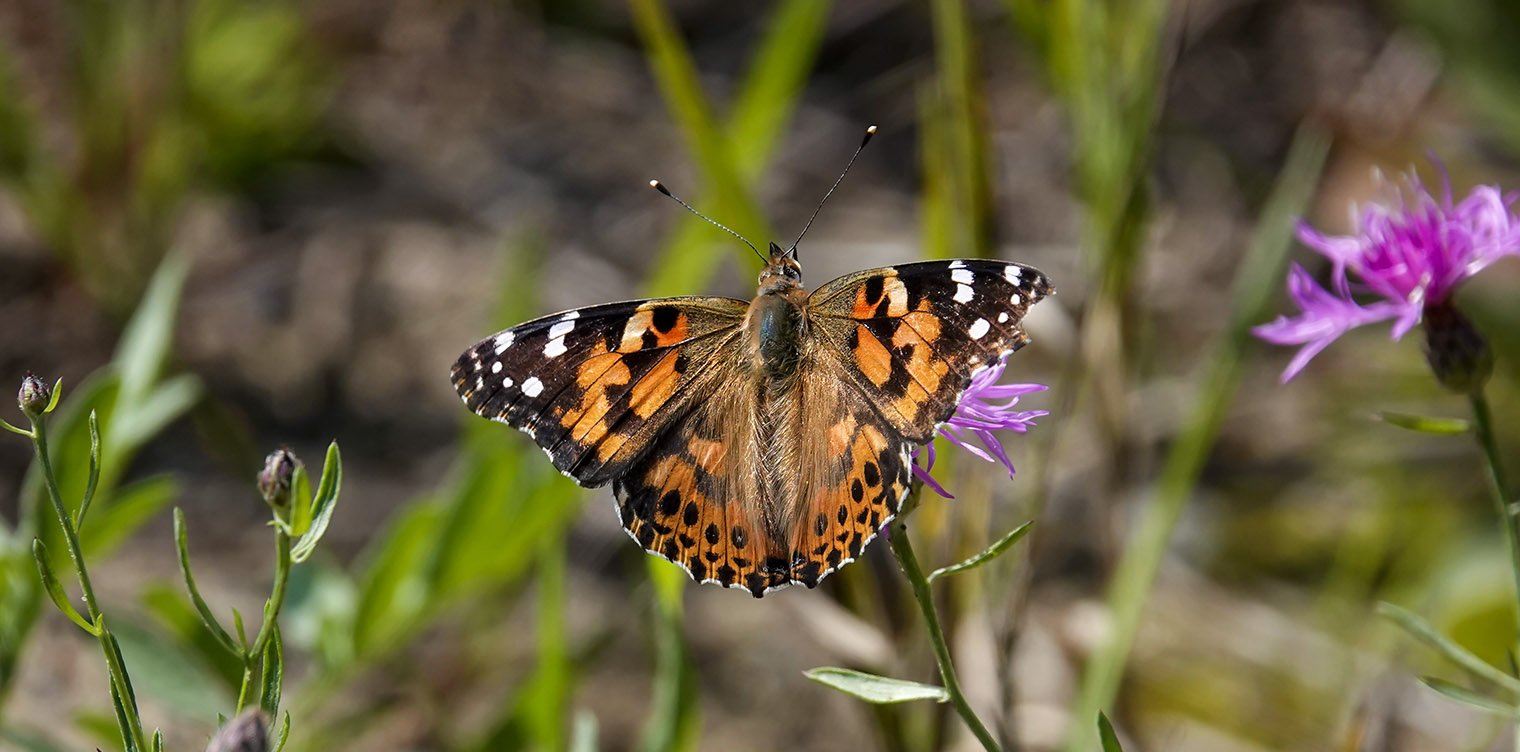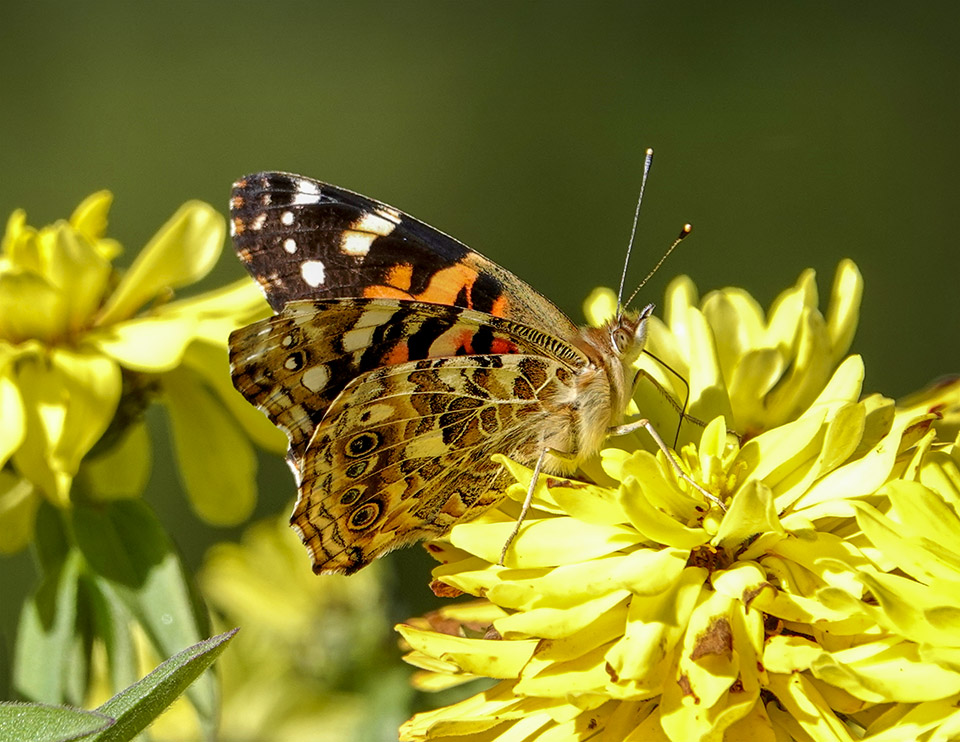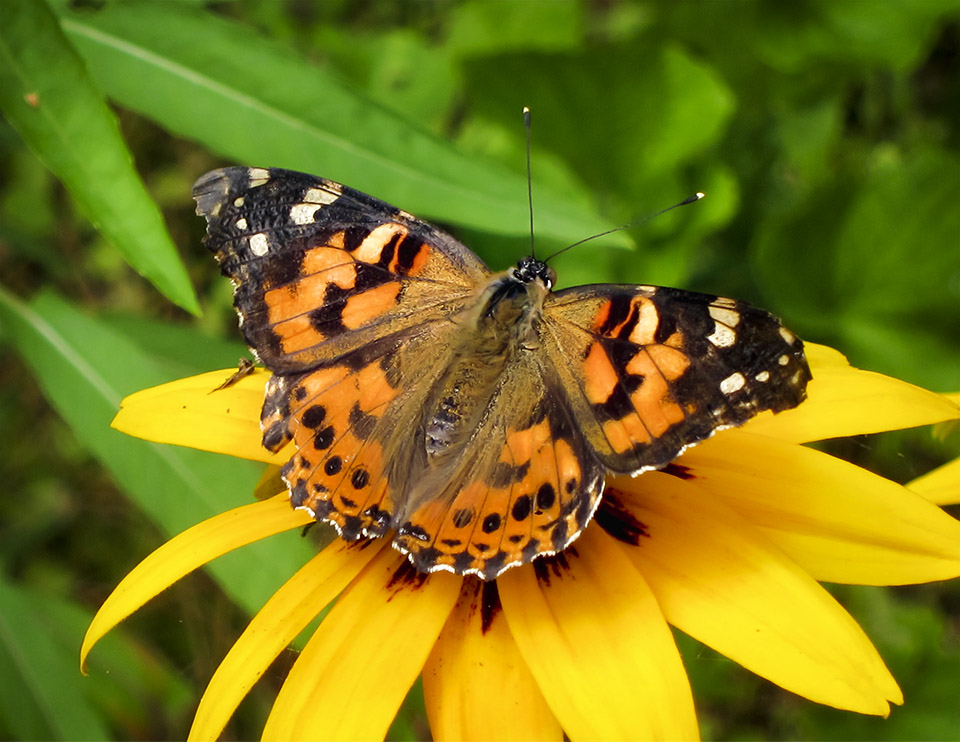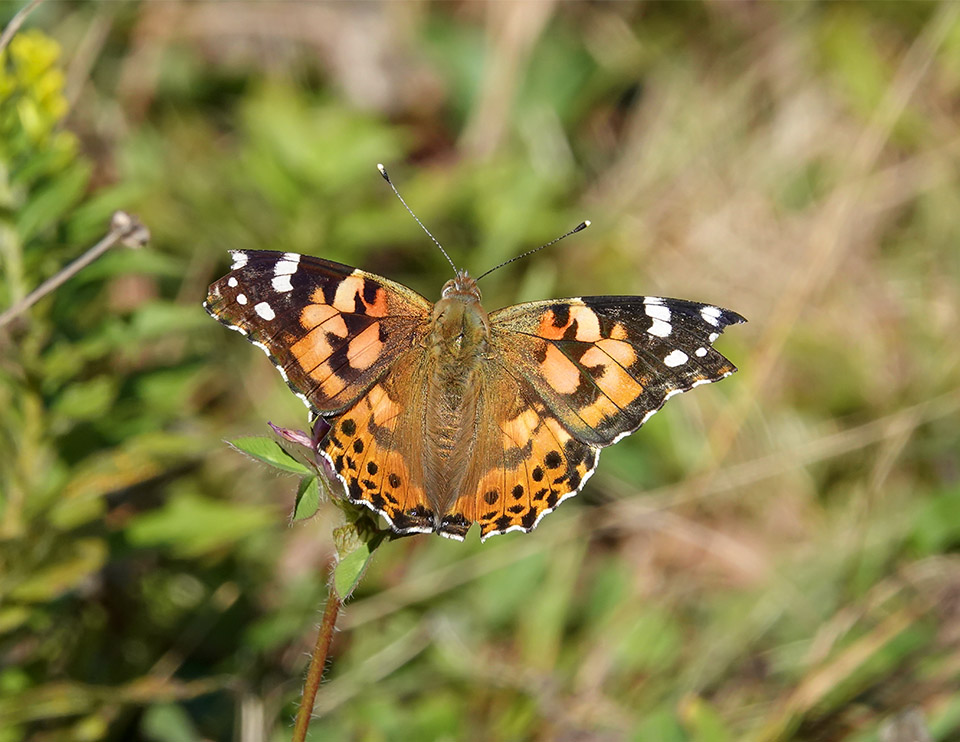Butterflies of the Adirondacks:
Painted Lady (Vanessa cardui)

The Painted Lady (Vanessa cardui) is a medium-sized, orange and black migratory butterfly usually seen in the Adirondack Mountains of upstate New York from July through September. It is a member of the Brushfoot family. [1]
- The Painted Lady is also known as the Thistle Butterfly [2] [3] – a reference to the caterpillars' food preference.
- Another name – Cosmopolitan – refers to the wide distribution of this butterfly. The Painted Lady is said to be the most widely distributed butterfly in the world. [4] [5] [6] [7]
- The scientific name cardui comes from the Latin carduus, which means "thistle;" this is another reference to the caterpillar's food plant. [8] [9]
Painted Lady: Identification
The Painted Lady is a medium-sized butterfly, with a wing span of about 2.2 inches. [10] From above, this butterfly is orange and brown,[11] darker at the wing base, with a bold black median band forming a semi-circle. The hind wing has a submarginal row of five small black spots.

From below, the Painted Lady is predominantly rose-pink with an olive, black, brown, and gray pattern and four small submarginal blue eye spots. [12] [13]
The Painted Lady is quite similar in appearance to the American Lady. There are several differences which help differentiate the two species.
- The Painted Lady has more pointed wings.
- The eye spots on the upper side of the Painted Lady's hind wing lack the blue centers seen on the American Lady. [14]
- The American Lady often has a small white spot in the orange cell by the upper wing margin, which helps distinguish it from the Painted Lady. [15]
- The row of submarginal dots on the hind wing are often connected by a smeary line in the American Lady, while those on the hind wing of the Painted Lady are not connected. [16]
- The underside of the American Lady has two large blue eye spots near the outer margin on an olive field on the hind wing. The Painted Lady, by contrast, has four smallish eye-spots. [17]
Painted Lady: Life History

Male Painted Ladies are territorial. They perch and patrol during the afternoon, looking for receptive females, usually on bare ground in open area. Males generally mate with multiple females to maximize their progeny. [18]
Female Painted Lady butterflies lay single eggs on host plant leaves. [19] The eggs are pale green with vertical ribs. [20] Host plants include thistles, hollyhocks, mallow, and various legumes. [21] The larvae which emerge feed on the host plant, molting several times before forming a brownish chrysalis. [22]
Adult Painted Ladies consume nectar from many different plant species, both native and nonnative plants. They are reported to nectar on summer-bloooming wildflowers such as asters, cosmos, blazing star, ironweed, Joe Pye Weed, Comomon Milkweed, Spotted Knapweed, and Red Clover. [23] They are said to prefer to obtain nectars from plants three to six feet high. [24]
Painted Lady: Habitat and Range

From the ecological standpoint, the Painted Lady butterfly is a generalist, [25] highly tolerant of different habitats. [26] [27] It can be found in heavily wooded areas, as well as open areas, such as waste areas, roadsides, farmers' fields, and areas where thistles abound. [28] [29] The Painted Lady has a very wide range, covering all continents except Australia and Antarctica.
On the North American continent, the Painted Lady overwinters in warm southern areas or in Mexico, and then migrates and temporarily colonizes the US and Canada south of the Arctic. [30] [31] [32] Sources conflict as to whether these butterflies make a return southbound migration.
- Some sources suggest that the Painted Ladies do not make a distinct southward migration in the fall, although some diffuse southern movements have been reported. [33]
- Other sources indicate that the Painted Lady makes a less conspicuous return migration, although not as large as springtime flights. [34]
Most sources agree that many of the immigrants die when temperatures fall in the North, to be replenished the following year by new migrants. [35] The number of immigrants reportedly fluctuates greatly from one year to the next. [36] [37] [38] Next to the Monarch butterfly, the Painted Lady is North America's most conspicuous migrant.[39]
Painted Lady: Flight
The flight period of Painted Ladies, as with all butterflies, varies with region and shifts from year to year. Most sources agree that the Painted Lady has multiple generations per year, with more broods in the south and fewer in the north. [40] [41] The flight period and the number of broods per year vary with latitude and elevation.
- In Wisconsin, there are reportedly two broods, with Painted Ladies flying from May through October. [42]
- Painted Lady numbers in Massachusetts vary significantly from year to year. During most years, few individuals are seen, while in others the species is quite numerous. Flight dates differ from year to year but the species is said to fly until the onset of cold weather. [43]
- In Vermont, records from the annual butterfly survey indicate the the Painted Lady occurs cyclically, being very abundant in some years and very scarce in others. Large flights occurred in that state in 2003 and 2005. Painted Ladies in Vermont reportedly fly until frost. [44]
- In the New York City region of New York State, the Painted Lady flies from late May through the end of September, with the largest number clustered in the third week of July and the last three weeks of August. [45]
The flight period and abundance of the Painted Lady within the Adirondack Park can only be roughly estimated, based mainly on verified sightings on Butterflies and Moths of North America (BAMONA) and reported observations on iNaturalist.
- The advantage of iNaturalist is that it is a popular citizen science web site that attracts many observers, in part because it covers both plants and animals and in part because the process of submitting an observation is very easy. The disadvantage is that an individual observation can achieve "research-grade" status by being confirmed by the observer and one additional individual, who may or may not have expertise in that particular taxa.
- The advantage of BAMONA is that sightings are verified by regional specialists who are recognized experts. The disadvantage is that there are fewer sighting records for most species, partly because the site covers only butterflies and moths and partly because the process of submitting a sighting is more complicated.
- Both data sets share a common problem of citizen science: reported trends may reflect trends in the number of observers and their willingness to submit reports, not the abundance of the butterfly in question. In addition, the Painted Lady is quite similar in appearance to the American Lady and can be easily confused with it if the observer does not have a clear view of the specimen. As a result, the number of recorded sightings may not reflect this species' abundance.
With these caveats in mind, it appears that the abundance of Painted Ladies varies significantly from year to year in the Adirondack region, similar to the pattern in other regions. Painted Ladies in the Adirondack Park usually fly in August and early September.
- Painted Ladies have been infrequent guests at the Paul Smith's College VIC Native Species Butterfly House (which collects butterflies from the adjacent Butterfly Garden and butterfly-rich sites within a short distance from the VIC.) The summer of 2012 was a very good year for Painted Ladies; this species was seen in the Paul Smiths VIC Native Species Butterfly House almost continuously from mid-July to early September. [46] In contrast, no Painted Ladies were reported in the Butterfly House logbooks for 2013, 2015, and 2016. [47]
- The list of BAMONA-verified sightings for Painted Ladies in the Adirondack Park includes only 14 sightings. Most are clustered in August, with several sightings in 2017 reported in late September and very early October. [48]
- Reported observations on iNaturalist suggest a similar pattern of boom and bust in terms of Painted Lady abundance. There have been 73 research-grade observations of Painted Ladies in the Adirondack Park, compared with 33 for American Ladies. [49] [50] The number of reported observations of Painted Ladies varied significantly from year to year. In 2016, there were no research-grade observations. [51] In 2017, there were 22 observations, from late July through October. [52] In 2018, there was one observation. [53] In 2019, there were 31 research-grade observations, most clustered in very late August and early September. [54] In 2020 and 2021, there were no observations. [55] [56]
References
- Susan Grimm Hanley. Interpretive Naturalist, Paul Smith's College Native Species Butterfly House. Species Logbooks. 2012, 2013, 2015, 2016.
- Butterflies and Moths of North America. Species Profiles. Painted Lady. Vanessa cardui. Retrieved 11 September 2019.
- Butterflies and Moths of North America. Sighting records. Painted Lady. 7/5/2012; 7/19/2012; 7/19/2012; 8/20/2012; 8/20/2012; 8/25/2012; 8/25/2012; 8/25/2012; 9/1/2012; 9/22/2017; 9/24/2017; 10/1/2017; 8/31/2019; 9/6/2019. Retrieved 11 September 2019.
- iNaturalist. Adirondack Park Sightings. Painted Lady. Retrieved 13 February 2022.
- iNaturalist. Adirondack Park Sightings. American Lady. Retrieved 13 February 2022.
- iNaturalist. Adirondack Park Sightings 2016. Painted Lady. Retrieved 13 February 2022.
- iNaturalist. Adirondack Park Sightings 2017. Painted Lady. Retrieved 13 February 2022.
- iNaturalist. Adirondack Park Sightings 2018. Painted Lady. Retrieved 13 February 2022.
- iNaturalist. Adirondack Park Sightings 2019. Painted Lady. Retrieved 13 February 2022.
- iNaturalist. Adirondack Park Sightings 2020. Painted Lady. Retrieved 13 February 2022.
- iNaturalist. Adirondack Park Sightings 2021. Painted Lady. Retrieved 13 February 2022.
- Government of Canada. Canadian Biodiversity Information Facility. SpeciesBank. Vanessa cardui. Retrieved 8 September 2019.
- Massachusetts Butterfly Club. Massachusetts Butterfly Species List. Painted Lady. Vanessa cardui. Retrieved 11 September 2019.
- Massachusetts Audubon. Butterfly Atlas Species Accounts. Painted Lady. Vanessa cardui. Retrieved 11 September 2019.
- Kent P. McFarland and Bryan Pfeiffer. Vermont Butterfly Survey. Vermont Center for Ecostudies – Vermont Atlas of Life. Painted Lady (Vanessa cardui). Retrieved 11 September 2019.
- Wisconsin Butterflies. Painted Lady. Vanessa cardui. Retrieved 11 September 2019.
- Montana Field Guides. Painted Lady. Vanessa cardui. Retrieved 11 September 2019.
- Iowa State University. Department of Entomology. BugGuide. Vanessa cardui. Painted Lady. Retrieved 11 September 2019.
- University of Michigan. Animal Diversity Web. Vanessa cardui. Retrieved 11 September 2019.
- Ross A. Layberry, Peter W. Hall, and J. Donald Lafontaine. The Butterflies of Canada (University of Toronto Press, 1998), pp. 205-206, Plate 17.
- National Audubon Society. Field Guide to Butterflies (New York: Alfred A. Knopf, 1981), pp. 625-626.
- Jim P. Brock and Kenn Kaufman. Kaufman Field Guide to Butterflies of North America (Houghton Mifflin, 2003), pp. 204-205.
- Paul A. Opler. A Field Guide to Eastern Butterflies (The Peterson Field Guide Series, Houghton Mifflin Company, 1992,1998), pp. 48-49, 88-89, 271-272.
- Jeffrey Glassberg. Butterflies of North America (Michael Friedman Publishing, 2002), pp. 148-150.
- James A. Scott. The Butterflies of North America. A Natural History and Field Guide (Stanford University Press, 1986), pp. 281-283.
- Donald and Lillian Stokes. Stokes Butterfly Book. The Complete Guide to Butterfly Gardening, Identification, and Behavior (Little, Brown and Company, 1991), pp. 72-75.
- Jeffrey Glassberg. Butterflies through Binoculars. The East. A Field Guide to the Butterflies of Eastern North America (Oxford University Press, 1999), p. 122-123, Plate 36.
- Paul A. Opler and George O. Krizek. Butterflies East of the Great Plains: An Illustrated Natural History (The Johns Hopkins University Press, 1984), pp. 159-160, Plate 29.
- Rick Cech and Guy Tudor. Butterflies of the East Coast. An Observer's Guide (Princeton University Press, 2005), p. 191.
- David Carter. Butterflies and Moths (Dorling Kindersley, Inc., 1992), p. 141.
- Thomas J. Allen, Jim P. Brock, and Jeffrey Glassberg. Caterpillars in the Field and Garden. A Field Guide to the Butterfly Caterpillars of North America (Oxford University Press, 2005), pp. 98-99.
